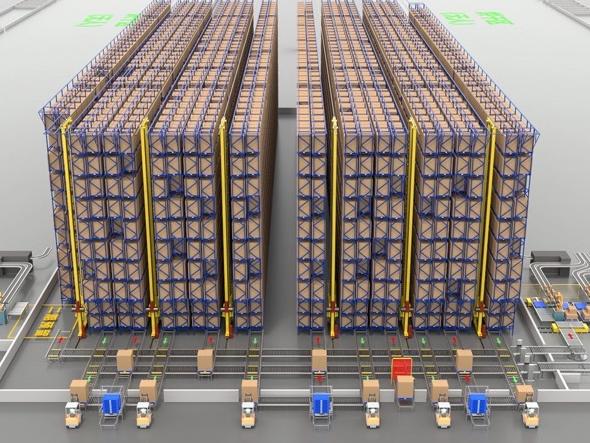Create Time: 05 ,22 ,2025
Picture a warehouse humming with efficiency, where goods are stored, retrieved, and moved with pinpoint accuracy—all without human labor. This isn't a glimpse into the distant future but the present-day capabilities of ASRS (Automated Storage and Retrieval Systems).
As businesses race to keep up with the demands of e-commerce, pharmaceuticals, manufacturing, and beyond, an ASRS warehouse system offers a transformative solution. These systems automate key warehouse processes, reducing manual errors, saving time, and optimizing storage space.
In this article, we’ll dive deep into the inner workings of ASRS, explore its core components, and outline the technology that powers modern warehouse automation. Understanding how an ASRS warehouse system works is critical for businesses aiming to stay competitive in a rapidly advancing market.
At its core, an ASRS warehouse system is an automated solution for storing and retrieving materials in a warehouse environment, using minimal human interaction. Instead of relying on forklifts and personnel, ASRS uses robotics, conveyors, and control software to handle inventory efficiently.
Storage Structures:
Items are stored vertically or densely in racks to maximize space.
Material Handling Equipment:
This includes cranes, robotic shuttles, and horizontal or vertical carousels that move items.
Control Software:
Warehouse Management Systems (WMS) oversee operations by tracking inventory and directing the ASRS components.
ASRS simplifies warehouse processes by:
Reducing manual effort.
Boosting speed and accuracy.
Enhancing storage density.
Its applications are diverse—from e-commerce warehouses fulfilling high-order volumes to cold storage facilities preserving temperature-sensitive goods.

To understand how an ASRS warehouse system works, let's break down its essential parts:
Vertical or Dense Storage: ASRS makes the best use of available space by utilizing vertical layouts or cube-based designs.
Storage Units: These systems can handle various units such as pallets, totes, and bins, depending on the warehouse’s needs.
Robotic Shuttles and Cranes: These automated machines retrieve or store items with precision.
Conveyors and Carousels: Transfer items between system components and picking stations for processing.
ASRS systems work hand-in-hand with Warehouse Management Systems (WMS) or Warehouse Execution Systems (WES) to oversee inventory and operations.
Real-time inventory tracking ensures constant system accuracy.
Workers interact with ASRS using dashboards or touchscreen systems for any manual overrides or monitoring.
Energy-efficient components minimize operational costs.
Regular maintenance is vital for smooth operations and avoiding downtime.
Here's a detailed walk-through of how an ASRS warehouse system operates:
System data begins with an inventory request to retrieve or store items. This data flows into the Warehouse Management System (WMS).
The ASRS software scans its database to identify the exact location of the product in the storage system.
Based on the request, cranes, robotic shuttles, or carousels activate to retrieve the inventory while minimizing human involvement.
The system picks items based on detailed SKU data. Whether via shuttles or conveyors, the inventory is retrieved smoothly and accurately.
Once retrieved, the item is routed to a picking station or packing line, ready for further processing or shipping.
After successful retrieval, the WMS automatically updates the inventory records in real time to ensure consistent accuracy.
The full process ensures timely, accurate, and efficient operations, cutting manual labor while boosting warehouse efficiency.
Using AI, ASRS systems can optimize picking paths, inventory placement, and retrieval orders, continually improving efficiency over time.
Sensors and IoT devices allow real-time data collection, helping warehouses monitor system performance and inventory movement seamlessly.
Robotic systems form the backbone of ASRS, efficiently handling storage and retrieval even in high-density operations.
ASRS excels in utilizing every inch of space—both vertically and horizontally—ensuring maximum storage capacity for warehouses.
By understanding the inner workings of ASRS warehouse systems, businesses can appreciate the benefits they offer:
Speed and Efficiency: Faster order retrieval and fulfillment.
Improved Accuracy: Reduced errors in order picking and inventory counts.
Labor Cost Savings: Automation reduces the number of repetitive tasks performed by workers.
Optimized Space Utilization: Vertical storage systems maximize the use of warehouse space.
Real-Time Inventory Management: Up-to-date inventory data improves operational flexibility.
Despite their benefits, ASRS systems come with challenges:
High Initial Costs: Significant upfront investments in machinery and software.
Compatibility Issues: The system must integrate smoothly with existing WMS solutions.
Maintenance Needs: Regular upkeep is required to keep the system running smoothly.
Non-Standard Inventory Handling: Irregularly shaped goods may not work seamlessly with some ASRS designs.
Solution Tips: Partnering with experienced vendors and consultants can overcome these hurdles for more effective implementation.
Automating high-volume order fulfillment for faster delivery times and reduced operational costs.
Ensuring the precise handling and tracking of medicines and medical supplies.
Managing heavy components and assembly line inventory efficiently.
Ideal for frozen food or temperature-sensitive goods, offering accuracy in extreme environments.
AI-Powered Decisions: Automation systems will self-optimize routes and workflows.
Advanced Robotics: Introducing cost-effective robotics for smaller-scale operations.
Eco-Friendly Designs: Focus on energy-efficient components for green warehouses.
Widened Accessibility for SMBs: Scalable solutions that meet small and medium businesses' needs affordably.
Perform an audit of your warehouse operations.
Identify key challenges (e.g., space constraints, high labor costs).
Choose the right ASRS system tailored to your workflows.
Evaluate potential ROI and investment costs.
Partner with reliable vendors to ensure seamless implementation.
The future of warehousing lies in automation, and ASRS warehouse systems are at the forefront of this transformation. By understanding how ASRS works, businesses stand to gain in efficiency, accuracy, and scalability.
Ready to automate and future-proof your warehouse operations? Contact us today to learn how an ASRS system can revolutionize your business!